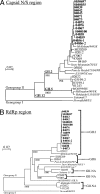Epidemic of genotype GII.2 noroviruses during spring 2004 in Osaka City, Japan
- PMID: 18495859
- PMCID: PMC2446922
- DOI: 10.1128/JCM.01993-07
Epidemic of genotype GII.2 noroviruses during spring 2004 in Osaka City, Japan
Abstract
Between March and May 2004, a GII.2 genotype norovirus strain caused an epidemic of acute gastroenteritis in Osaka, Japan. Phylogenetic analysis showed that this strain was distinct from all other GII.2 strains detected in Osaka City between April 1996 and March 2005.
Figures

References
-
- Ando, T., J. S. Noel, and R. L. Fankhauser. 2000. Genetic classification of “Norwalk-like viruses.” J. Infect. Dis. 181(Suppl. 2)S336-S348. - PubMed
-
- Gallimore, C. I., M. Iturriza-Gomara, J. Xerry, J. Adigwe, and J. J. Gray. 2007. Inter-seasonal diversity of norovirus genotypes: emergence and selection of virus variants. Arch. Virol. 1521295-1303. - PubMed
-
- Green, K. Y. 2007. Caliciviridae: the noroviruses, p. 949-979. In D. M. Knipe, P. M. Howley, D. E. Griffin, R. A. Lamb, M. A. Martin, B. Roizman, and S. E. Straus (ed.), Fields virology, 5th ed. Lippincott Williams & Wilkins, Philadelphia, PA.
Publication types
MeSH terms
Substances
Associated data
- Actions
- Actions
- Actions
LinkOut - more resources
Full Text Sources
Medical
Miscellaneous

